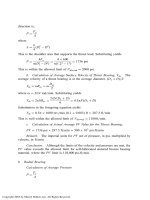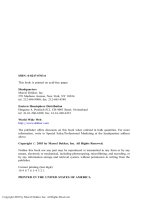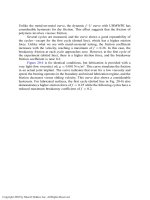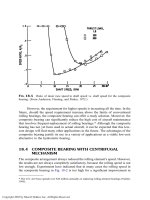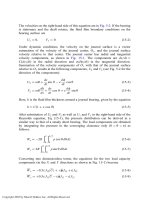Bearing Design in Machinery Episode 3 Part 9 potx
Bạn đang xem bản rút gọn của tài liệu. Xem và tải ngay bản đầy đủ của tài liệu tại đây (268.74 KB, 16 trang )
steady conditions, the journal center O
1
does not move relative to the bearing
sleeve, and the friction force remains constant. In practice, these steady condi-
tions will come about after a transient interval for damping of any initial motion
of the journal center. When there is a motion of the journal center O
1
, however,
the oil film thickness and the friction force are not constant, which explains the
dynamic effects of unsteady friction.
Before proceeding with the development of the dynamic model, the model
for steady friction in the mixed lubrication region is presented. Dubois and
Ocvirk (1953) derived the equations for full hydrodynamic lubrication of a short
bearing. The following is an extension of this analysis to the mixed lubrication
region. In the mixed region there is direct contact between the surface asperities
combined with hydrodynamic load capacity. The theory is for a short journal
bearing, because it is widely used in machinery, and because the steady
performance of a short bearing in the full hydrodynamic region is already well
understood and can be described by closed-form equations.
The mixed lubrication region is where the hydrodynamic minimum film
thickness, h
n
, is below a certain small transition magnitude, h
tr
. Under load, the
asperities are subject to elastic as well as plastic deformation due to the high-
pressure contact at the tip of the asperities. Although the load is distributed
unevenly between the asperities, the average elastic part of the deformation is
described by the elastic recoverable displacement, d, of the surfaces toward each
other, in the direction normal to the contact area. The reaction force between the
asperities of the two surfaces is an increasing function of the elastic, recoverable
part of the deformation, d. The normal reaction force of the asperities as a
function of d is similar to that of a spring; however, this springlike behavior is not
linear.
In a journal bearing in the mixed lubrication region, the average normal
elastic deformation, d of the asperities is proportional to the difference between
the transition minimum film thickness, h
tr
, and the actual lower minimum film
thickness, h
n
:
d ¼ h
tr
À h
n
ð17-1Þ
The elastic reaction force, W
e
, of the asperities is similar to that of a nonlinear
spring:
W
e
¼ k
n
ðdÞ d ð17-2Þ
where k
n
ðdÞ is the stiffness function of the asperities to elastic deformation in the
direction normal to the surface. The contact areas between the asperities increase
with the load and deformation d. Therefore, k
n
ðdÞ is an increasing function of d.
Copyright 2003 by Marcel Dekker, Inc. All Rights Reserved.
If the elastic reaction force, W
e
, between the asperities is approximated by a
contact between two spheres, Hertz theory indicates that the reaction force, W
e
,is
proportional to d
3=2
:
W
e
/ d
3=2
ð17-3Þ
and Eq. (17-2) becomes
W
e
¼ k
n
d ) k
n
¼ k
0
d
1=2
ð17-4Þ
Here, k
0
is a constant which depends on the geometry and the elastic modulus of
the two materials in contact. In fact, an average asperity contact is not identical to
that between two spheres, and a better modeling precision can be obtained by
determining empirically the two constants, k
0
and n, in the following expression
for the normal stiffness:
k
n
¼ k
0
d
n
ð17-5Þ
The two constants are selected for each material combination to give the best fit to
the steady Stribeck curve in the mixed lubrication region.
For a journal bearing, the average elastic reaction of surface asperities in the
mixed region, W
e
in Eq. (17-2), can be expressed in terms of the eccentricity
ratio, e ¼ e=C. In addition, a transition eccentricity ratio, e
tr
, is defined as the
eccentricity ratio at the point of steady transition from mixed to hydrodynamic
lubrication (in tests under steady conditions). This transition point is where the
friction is minimal in the steady Stribeck curve.
The elastic deformation, d (average normal asperity deformation), in Eq.
(17-1) at the mixed lubrication region can be expressed in terms of the difference
between e and e
tr
:
d ¼ Cðe À e
tr
Þð17-6Þ
and the expression for the average elastic reaction of the asperities in terms of the
eccentricity ratio is
W
e
¼ k
n
ðeÞðe À e
tr
ÞD ð17-7Þ
The elastic reaction force, W
e
, is only in the mixed region, where the difference
between e and e
tr
is positive. For this purpose, the notation D is defined as
D ¼
1ifðe À e
tr
Þ > 0
0ifðe Àe
tr
Þ 0
&
ð17-8Þ
In a similar way to Eq. (17-5), k
n
ðeÞ is a normal stiffness function, but it is a
function of the difference of e and e
tr
,
k
n
ðeÞ¼k
0
ðe À e
tr
Þ
n
ð17-9Þ
Copyright 2003 by Marcel Dekker, Inc. All Rights Reserved.
In the case of a spherical asperity, n ¼ 0:5andk
0
is a constant. In actual contacts,
the magnitude of the two constants n and k
0
is determined for the best fit to the
steady (Stribeck) f –U curve. In Eq. (17-7), D ¼ 0 in the full hydrodynamic
region, and the elastic reaction force W
e
, is also zero. But in the mixed region,
D ¼ 1, and the elastic reaction force W
e
is an increasing function of the
eccentricity ratio e.
In the mixed region, the total load capacity vector
~
WW of the bearing is a
vector summation of the elastic reaction of the asperities,
~
WW
e
and the hydro-
dynamic fluid film force,
~
WW
h
:
~
WW ¼
~
WW
e
þ
~
WW
h
ð17-10Þ
The bearing friction force, F
f
, in the tangential direction is the sum of contact and
viscous friction forces. The contact friction force is assumed to follow Coulomb’s
law; hence, it is proportional to the normal contact load, W
e
, while the
hydrodynamic, viscous friction force follows the short bearing equation; see
Eq. (7-27). Also, it is assumed that the asperities, in the mixed region, do not have
an appreciable effect on the hydrodynamic performance.
Under these assumptions, the equation for the total friction force between
the journal and sleeve of a short journal bearing over the complete range of
boundary, mixed, and hydrodynamic regions is
F
f
¼ f
m
k
n
ðeÞCðe À e
tr
ÞD sgnðUÞþ
LRm
C
2
2p
ð1 Àe
2
Þ
0:5
U ð17-11Þ
Here, f
m
is the static friction coefficient, L and R are the length and radius of the
bearing, respectively, C is the radial clearance, and m is the lubricant viscosity.
The friction coefficient of the bearing, f , is a ratio of the friction force and the
external load, f ¼ F
f
=F. The symbol sgnðU Þ means that the contact friction is in
the direction of the velocity U.
17.4 MODELING FRICTION AT STEADY
VELOCI TY
The load capacity is the sum of the hydrodynamic force and the elastic reaction
force. The equations for the hydrodynamic load capacity components of a short
journal bearing [Eq. (7–16)] were derived by Dubois and Ocvirk, 1953. The
Copyright 2003 by Marcel Dekker, Inc. All Rights Reserved.
following equations extend this solution to include the hydrodynamic compo-
nents and the elastic reaction force:
F cosðf ÀpÞ¼k
n
ðeÞC ðe Àe
tr
ÞD þ
e
2
ð1 Àe
2
Þ
2
mL
3
C
2
jUjð17-12Þ
F sinðf ÀpÞ¼
pe
2
ð1 À e
2
Þ
2
mL
3
C
2
U ð17-13Þ
The coordinates f and e (Fig. 15-1) describe the location of the journal center in
polar coordinates. The direction of the elastic reaction W
e
is in the direction of X.
In Eq. (17-12), the external load component F
x
is equal to the sum of the
hydrodynamic force component due to the fluid film pressure and the elastic
reaction W
e
, at the point of minimum film thickness. In Eq. (17-13), the load
component F
y
is equal only to the hydrodynamic reaction, because there is no
contact force in the direction of Y.
For any steady velocity U in the mixed region, ðe > e
tr
Þ and for specified
C; L; F; m and k
n
ðeÞ, Eqs. (17-12 and 17-13) can be solved for the two unknowns,
f and e. Once the relative eccentricity, e, is known, the friction force F
f
can be
calculated from Eq. (17-11), and the bearing friction coefficient, f , can be
obtained for specified R and f
m
. By this procedure, the Stribeck curve can be
plotted for the mixed and hydrodynamic regions.
For numerical solution, there is an advantage in having Eqs. (17-12) and
(17-13) in a dimensionless form. These equations can be converted to dimension-
less form by introducing the following dimensionless variables:
U ¼
U
U
tr
; F ¼
C
2
mU
tr
L
3
F; k ¼
C
3
mU
tr
L
3
k
n
ð17-14Þ
Here
k is a dimensionless normal stiffness to deformation at the asperity contact.
The deformation is in the direction normal to the contact area. The velocity U
tr
is
at the transition from mixed to hydrodynamic lubrication (at the point of
minimum friction in the f –U chart). The dimensionless form of Eqs. (17-12)
and (17-13) is
F cosðf ÀpÞ¼kðeÞðe Àe
tr
ÞD À0:5J
12
e j U jð17-15Þ
F sinðf ÀpÞ¼0:5J
11
e U ð17-16Þ
The integrals J
11
and J
12
are defined in Eqs. (7-13). Equations (17-15) and (17-
16) apply to the mixed as well as the hydrodynamic lubrication regions in the
Stribeck curve.
Copyright 2003 by Marcel Dekker, Inc. All Rights Reserved.
17.5 MODELING DYNAMIC FRICTION
For the purpose of developing the dynamic friction model, the existing hydro-
dynamic short bearing theory of Dubois and Ocvirk is extended to include the
mixed region and dynamic conditions.
The assumptions of hydrodynamic theory of steady short bearings are
extended to dynamic conditions. The pressure gradients in the x direction (around
the bearing) are neglected, because they are very small in comparison with the
gradients in the z (axial) direction (for directions, see Fig. 7-1). Similar to the
analysis of a steady short bearing (see Chapter 7), only the pressure wave in the
region 0 < y < p is considered for the fluid film force calculations. In this region,
the fluid film pressure is higher than atmospheric pressure. In addition, the
conventional assumptions of Reynolds’ classical hydrodynamic theory are main-
tained. The viscosity, m, is assumed to be constant (at an equivalent average
temperature). The effects of fluid inertia are neglected, but the journal mass is
considered, for it is of higher order of magnitude than the fluid mass.
Recall that under dynamic conditions the equations of motion are (see
Chapter 15)
~
FF À
~
WW ¼ m
~
aa ð17-17Þ
Writing Eq. (17-17) in components in the direction of W
x
and W
y
(i.e., the radial
and tangential directions in Fig. 15-1), the following two equations are obtained
in dimensionless terms:
F
x
À W
x
¼ m
€
ee À me
_
ff
2
ð17-18Þ
F
y
À W
y
¼Àme
€
ff À 2m
_
ee
_
ff; ð17-19Þ
where the dimensionless mass and force are defined, respectively, as
m ¼
C
3
mL
3
R
2
m; F ¼
C
2
mU
tr
L
3
F ð17-20Þ
Under dynamic conditions, the equations for the hydrodynamic load capacity
components of a short journal bearing are as derived in Chapter 15. These
equations are used here; in this case, however, the velocity is normalized by the
transition velocity, U
tr
. In a similar way to steady velocity, the load capacity
components are due to the hydrodynamic pressure and elastic reaction force
W
x
¼ kðeÞðe À e
tr
ÞD À 0:5J
12
e j U jþJ
12
e
_
ff þ J
22
_
ee ð17-21Þ
W
y
¼ 0:5eJ
11
U À J
11
e
_
ff À J
12
_
ee ð17-22Þ
Copyright 2003 by Marcel Dekker, Inc. All Rights Reserved.
Substituting these hydrodynamic and reaction force in Eqs. (17-18) and (17-19)
yields
FðtÞcosðf À pÞ¼kðe Àe
tr
ÞD À 0:5eJ
12
jUjþJ
12
e
_
ff þ J
22
_
ee þ
m
€
ee Àm
_
ff
2
ð17-23Þ
FðtÞsinðf À pÞ¼0:5eJ
11
U À J
11
e
_
ff À J
12
_
ee À
me
€
ff À 2m
_
ee
_
ff ð17-24Þ
Here
FðtÞ is a time-dependent dimensionless force acting on the bearing. The
magnitude of this external force, as well as its direction is a function of time. In
the two equations, e is the eccentricity ratio, f is defined in Fig. 15-1, and
m is
dimensionless mass, defined by Eq. (17-20). The definition of the integrals J
ij
and
their solutions are in Eqs. (7-13).
Equations (17-23) and (17-24) are two differential equations, which are
required for the solution of the two time-dependent functions e and f. The
solution of the two equations for e and f as a function of time allows the plotting
of the trajectory of the journal center O
1
in polar coordinates.
These two differential equations yield the time-variable eðtÞ, which in turn
can be substituted into Eq. (17-11) for the computation of the friction force. For
numerical computations, it is convenient to use the following dimensionless
equation for the friction force obtained from Eq. (17-11):
F
f
¼ f
m
kðeÞC ðe Àe
tr
ÞD sgnðUÞþ
RC
L
2
2p
ð1 Àe
2
Þ
0:5
U ð17-25Þ
The dimensionless friction force and velocity are defined in Eq. (17-14). The
friction coefficient of the bearing is the ratio of the dimensionless friction force
and external load:
f ¼
F
f
F
ð17-26Þ
The set of three equations (17-23), (17-24) and (17-25) represents the dynamic
friction model. For any time-variable shaft velocity UðtÞ and time-variable load,
the friction coefficient can be solved as a function of time or velocity.
This model can be extended to different sliding surface contacts, including
EHD line and point contacts as well as rolling-element bearings. This can be done
by replacing the equations for the hydrodynamic force of a short journal bearing
with that of a point contact or rolling contact. These equations are already known
from elastohydrodynamic lubrication theory; see Chapter 12.
Copyright 2003 by Marcel Dekker, Inc. All Rights Reserved.
17.6 COMPARISON OF MODEL SIMULATIONS
AND EXPERIMENTS
Dynamic friction measurements were performed with the four-bearing measure-
ment apparatus, which was described in Sec. 14.7. A computer with on-line data-
acquisition system was used for plotting the results and analysis.
The model coefficients are required for comparing model simulations and
experimental f –U curves under dynamic conditions. The modeling approach is to
determine the model coefficients from the steady Stribeck curve. Later, the model
coefficients are used to determine the characteristics under dynamic conditions.
In order to simplify the comparison, Eq. (17-25) has been modified and the
coefficient g introduced to replace a combination of several constants:
F
f
¼ f
m
kðeÞC ðe Àe
tr
ÞD sgnðUÞþg
2p
ð1 Àe
2
Þ
0:5
U ð17-27Þ
Here, f
m
is the stiction friction coefficient and g is a bearing geometrical
coefficient. The friction force has two components: The first term is the contact
component due to asperity interaction, and the second term is the viscous shear
component. The normal stiffness constant, k
0
, is selected by iterations to result in
the best fit with the Stribeck curve in the mixed region.
A few examples are presented of measured curves of a test bearing (Table
17-1) as compared to theoretical simulations. The experiments were conducted
under constant load and oscillating sliding velocity.
Friction measurements for bidirectional sinusoidal velocity were conducted
under loads of 104 N and 84 N for each of the four test sleeve bearings. The
analytical model was simulated for the following periodic velocity oscillations:
U ¼ 0:127 sinðotÞð17-28Þ
Here, o is the frequency (rad=s) of sliding velocity oscillations and U is the
sliding velocity of the journal surface. The four-bearing apparatus was used to
measure the dynamic friction between the shaft and the four sleeve bearings.
Multigrade oil was applied, because the viscosity is less sensitive to variations of
temperature, but it still varied initially by dissipation of friction energy during the
TABLE 17-1 Data from Friction Measurement Apparatus
Diameter of bearing ðD ¼ 2RÞ D ¼0.0254 m
Length of bearing L ¼0.019 m
Radial clearance in bearing C ¼0.05 mm
Mass of journal m ¼2.27 kg
Bearing material Brass
Oil SAE 10W-40
Copyright 2003 by Marcel Dekker, Inc. All Rights Reserved.
test. After several cycles, however, a steady state was reached in which repeat-
ability of the experiments was sustained.
For each bearing load, the Stribeck curve was initially produced by our
four-bearing testing apparatus and used to determine the optimal coefficients
required for the dynamic model in Eqs. (17-23), (17-24), and (17-27). The
stiction friction coefficient, f
m
and velocity at the transition, U
tr
, were taken
directly from the experimental steady Stribeck curve. The geometrical coefficient,
g, was determined from the slope in the hydrodynamic region, while the
coefficient k
0
was determined to obtain an optimal fit to the experimental Stribeck
curve in the mixed region. All other coefficients in Table 17-2, such as viscosity
and bearing dimensions, are known. These constant coefficients, determined from
the steady f –U curve, were used later for the simulation of the following f –U
curves under dynamic conditions.
17.6.1 Bearing Load of 104N (Table 17-2,
Figs. 17-1, 17-2, 17-3)
TABLE 17-2 Model Parameters for a Load of 84 N
f
m
¼0.26 k
0
¼7.5 Â10
5
m ¼0.02 N-s=m
2
U
tr
¼0.06 m=s F ¼104 N C ¼ 5:08e
À5
m
e
tr
¼0.9727 m ¼2.27 kg g ¼ 0:0011
FIG. 17-1 Comparison of measured and theoretical f –U curves for sinusoidal sliding
velocity: load¼104 N, U ¼ 0:127 sinð0:045tÞm=s, oscillation frequency ¼0.045 rad=s
(measurement , simulation —).
Copyright 2003 by Marcel Dekker, Inc. All Rights Reserved.
17.6.2 Bearing Under Load of 84 N (Table 17-3,
Figs. 17-4, 17-5, 17-6)
FIG. 17-4 Comparison of measured and theoretical f –U curves for sinusoidal sliding
velocity: load ¼84 N, U ¼ 0:127 sinð0:1tÞm=s, oscillation frequency ¼0.1 rad=s
(measurement , simulation —).
TABLE 17-3 Model Parameters for a Load of 84 N
f
m
¼0.26 k
0
¼6.25 Â10
5
m ¼0.02 N-s=m
2
U
tr
¼0.05 m=s F ¼84 N C ¼ 5:08e
À5
m
e
tr
¼0.9718 m ¼2.27 kg g ¼0.0011
FIG. 17-5 Comparison of measured and theoretical f –U curves for sinusoidal sliding
velocity: load¼84 N, U ¼ 0:127 sinð0:25tÞm=s, oscillation frequency ¼0.25 rad=s
(measurement , simulation —).
Copyright 2003 by Marcel Dekker, Inc. All Rights Reserved.
The explanation for the reduction in the magnitude of the stiction force at
higher frequencies is as follows: At high frequency there is insufficient time for
the fluid film to be squeezed out. As the frequency increases, the fluid film is
thicker, resulting in lower stiction force at velocity reversals.
Copyright 2003 by Marcel Dekker, Inc. All Rights Reserved.
18
Case Study
Composite BearingöRolling Elements and
Fluid Film in Series
18.1 INTRODUCTION
A composite bearing of rolling and hydrodynamic components in series is a
unique design that was proposed initially to overcome two major disadvantages of
hydrodynamic journal bearings: Severe wear during start-up and stopping, and
risk of catastrophic failure during any interruption of lubricant supply.
18.1.1 Star t-Up and Stopping
Hydrodynamic bearings are subjected to severe wear during the starting and
stopping of journal rotation. In addition, in variable-speed machines, when a
bearing operates at low-speed, there is no full fluid film, resulting in wear. In these
cases, there is also a risk of bearing failure due to overheating, which is a major
drawback of hydrodynamic journal bearings.
In theory, there is a very thin fluid film even at low journal speeds. But in
practice, due to surface roughness, vibrations, and disturbances, a critical
minimum speed is required to generate adequate fluid film thickness for complete
separation of the sliding surfaces. During start-up, wear is more severe than
during stopping, because the bearing accelerates from zero velocity, where there
is relatively high static friction. In certain cases, there is stick-slip friction during
Copyright 2003 by Marcel Dekker, Inc. All Rights Reserved.
bearing start-up (see Harnoy 1966). During start-up, as speed increases, the fluid
film builds up and friction reduces gradually.
18.1.2 Interruption of Oil Supply
A hydrodynamic bearing has a high risk of catastrophic failure whenever the
lubricant supply is interrupted, even for a short time. The operation of a
hydrodynamic journal bearing is completely dependent on a continuous supply
of lubricant, particularly at high speed. If the oil supply is interrupted, this can
cause overheating and catastrophic (sudden) bearing failure. At high speed, heat
is generated at a fast rate by friction. Without lubricant, the bearing can undergo
failure in the form of melting of the bearing lining. The lining is often made of a
white metal of low melting temperature. Under certain conditions, interruption of
the oil supply can result in bearing seizure (the journal and bearing weld
together).
Interruption of the oil supply can occur for several reasons, such as a failure
of the oil pump or its motor. In addition, the lubricant can be lost due to a leak in
the oil system. This risk of failure prevents the use of hydrodynamic bearings in
critical applications where safety is a major concern, such as in aircraft engines.
Replacing the hydrodynamic journal bearing with an externally pressurized
hydrostatic journal bearing can eliminate the severe wear during starting and
stopping. But a hydrostatic journal bearing is uneconomical for many applica-
tions because it needs a hydraulic system that includes a pump and an electric
motor. For many machines, the use of hydrostatic bearings is not feasible. In
addition, an externally pressurized hydrostatic bearing does not eliminate the risk
of catastrophic failure in the case of oil supply interruption.
18.1.3 Limitati ons of Rolling Bearings
Rolling bearings are less sensitive than hydrodynamic bearings to starting and
stopping. However, rolling bearing fatigue life is limited, due to alternating
rolling contact stresses, particularly at very high speed. This problem is expected
to become more important in the future because there is a continuous trend to
increase the speed of machines. Manufacturers continually attempt to increase
machinery speed in order to reduce the size of machines without reducing power.
It was shown in Chapter 12 that at very high speeds, the centrifugal forces
of the rolling elements increase the contact stresses. At high speeds, the
temperature of a rolling bearing rises and the fatigue resistance of the material
deteriorates. The centrifugal forces and temperature exacerbate the problem and
limit the speed of reliable operation. Thus the objective of long rolling bearing
life and that of high operating speeds are in conflict. In conclusion, the optimum
operation of the rolling bearing occurs at relatively low and medium speeds, while
Copyright 2003 by Marcel Dekker, Inc. All Rights Reserved.
the best performance of the hydrodynamic bearing happens at relatively high
speeds.
Over the years, there has been considerable improvement in rolling bearing
materials. By using bearings made of high-purity specialty steels, fatigue life has
been extended. High-quality rolling bearings made of specialty steels involve
higher cost. These bearings are used in aircraft engines and other unique
applications where the high cost is justified. However, since there is a continual
requirement for faster speeds, the fatigue life of rolling bearings will continue to
be a bottleneck in the future for the development of faster machines.
It would offer considerable advantage if the bearing could operate in a
rolling mode at low speed and at higher speed would convert to hydrodynamic
fluid film operation. In fact, this is the purpose of the composite bearing that
utilizes the desirable features of both the hydrodynamic and the rolling bearing by
combining them in series. In addition, if the oil supply is interrupted, the bearing
will work in the rolling mode only and thus eliminate the high risk of failure of
the common fluid film bearing.
In the following discussion, it is shown that it is possible to mitigate the
drawbacks of the hydrodynamic journal bearing by using a composite bearing,
which is a unique design of hydrodynamic and rolling bearings in series. In
previous publications, this design was also referred to as the series hybrid
bearing, the angular-compliant bearing and hydro-roll.
18.2 COMPOSITE-BEARING DESIGNS
The combination was tested initially (Harnoy 1966; Lowey, Harnoy, and Bar-Nefi
1972) by inserting the journal directly in the rolling-element inner ring bore; see
Fig. 18-1. They used a radial clearance commonly accepted in hydrodynamic
journal bearings of the order of magnitude C % 10
À3
 R. Later, this combina-
tion was improved (see Harnoy 1966), by inserting a sleeve at a tight fit into the
bore of the rolling bearing; see Fig. 18-2. The journal runs on a fluid film in a
free-fit clearance inside the bore of this sleeve. In this way, the desired sleeve
material and surface finish can be selected as well as the ratio of the length and
diameter, L=D, of the sleeve. In many applications, a self-aligning rolling element
is desirable to ensure parallelism of the fluid film surfaces. The lubrication is an
oil bath arrangement. The oil is fed in the axial direction of the clearance to form
a fluid film between the journal and the sleeve; see Fig. 18-2.
Anderson* (1973) suggested a practical combination for use in gas
turbines; see Fig. 18-3. This is a combination of a conical hydrodynamic bearing
* It is interesting that the work by the NASA group headed by Anderson and that of Lowey, Harnoy
and Bar-Nefi in the Technion–Israel Institute of Technology were performed independently, without
any knowledge of each other’s work.
Copyright 2003 by Marcel Dekker, Inc. All Rights Reserved.
in Chapter 8; measurement methods are covered in Chapter 14. The following
discussion shows that the composite bearing, in fact, improves the friction
characteristics by eliminating the high start-up friction of a fluid-film bearing.
The sleeve bearing friction curve in Fig. 18-4 has high friction in the
boundary and mixed lubrication regions because the sliding surface asperities are
in direct contact at low speed. In the hydrodynamic lubrication region, the sliding
surfaces are separated by a fluid film and viscous friction is increasing almost
linearly with speed. The curve for rolling bearing friction is similar, but start-up
friction and high-speed friction are much lower than that of the common sleeve
bearing.
The purpose of the composite bearing is to avoid the high friction in the
boundary lubrication region and most of the mixed region of a sleeve bearing. In
Fig. 18-4, the dotted line shows the expected friction characteristic of a properly
designed composite bearing. During start-up, the composite bearing operates as a
rolling bearing and the starting friction is as low as in a rolling bearing. The
friction coefficient at the high rated speed is expected to be somewhat lower than
for a regular journal bearing. This is because the viscous friction is proportional
to the sliding speed only and the total speed of a composite bearing is divided into
rolling and sliding parts.
18.2.2 Composite- Bearing Start-Up
During start-up, the sliding friction of a hydrodynamic bearing is higher than that
of a rolling bearing. Therefore, sliding between the journal and the sleeve is
FIG. 18-4 Friction coefficient as a function of speed. (From Harnoy and Khonsari,
1996.)
Copyright 2003 by Marcel Dekker, Inc. All Rights Reserved.
replaced by a rolling action (similar to that in an internal gear mechanism). Thus
the surface velocity of the shaft, Ro
j
, is equal to the velocity of the sleeve bore
surface, R
1
o
b
. The velocities are shown in Fig. 18-1. The difference between the
journal and bore surface radii is small and negligible, so we can assume R
1
¼ R.
An important aspect in the operation of a composite bearing is that the
friction during the transition from rolling to sliding is significantly lower than for
a regular start-up of a regular hydrodynamic journal bearing. The friction is lower
because the initial rolling generates a fluid film between the rolling surfaces of the
journal and the sleeve bore. This effect is explained next according to hydro-
dynamic theory.
18.2.3 Analysis of Start-up
For bearings under steady conditions, if the bearing sleeve and the journal are
rotating at different speeds, the Reynolds equation for incompressible and
isothermal conditions reduces to the following form [see Eq. (6-21b)]:
@
@x
h
3
m
@p
@x
þ
@
@z
h
3
m
@p
@z
¼ 6Rðo
j
þ o
b
Þ
@h
@x
ð18-1Þ
The surface velocities of bearing and journal, Ro
j
and R
1
o
b
, respectively,
are shown in Fig. 18-1. In Eq. (18-1), p is the pressure and h is the fluid film
thickness. For a regular journal bearing, there is only journal rotation, i.e., one
surface has velocity Ro
j
while the sleeve is stationary. After integration of Eq.
(18-1), the pressure distribution in the fluid film and the load capacity are directly
proportional to the sum Rðo
j
þ o
b
Þ.
During start-up, there is only the rolling mode, and the boundary conditions
of the fluid film are
Ro
j
¼ R
1
o
b
ð18-2Þ
In comparison, in a regular journal bearing of a stationary sleeve, o
b
¼ 0.
Therefore, in the case of pure rolling, the sum of the velocities is double that
of pure sliding in a common journal bearing. This means that during start-up, the
fluid film pressure of a composite bearing is double that in a common hydro-
dynamic journal bearing, where o
b
¼ 0. In the rolling mode, only half of the
journal speed is required to generate the film thickness of a regular bearing with a
stationary sleeve. This film of the rolling mode prevents wear and high friction at
the transition from rolling to sliding.
The physical explanation is that the fluid is squeezed faster by the rolling
action than by sliding. Doubling the pressure via rolling action is well known for
those involved in the analysis of EHD lubrication of rolling elements.
Copyright 2003 by Marcel Dekker, Inc. All Rights Reserved.
18.3 PREVIOUS RESEARCH IN COMPOSITE
BEARINGS
Experiments by Harnoy (1966) demonstrated that the composite bearing operates
as a rolling element during starting and stopping, while hydrodynamic sliding is
initiated at higher speeds. At the high rated speed, the rolling element rotates at a
reduced speed because the speed is divided between rolling and sliding modes
according to a certain ratio. The reduction of the rolling-element speed offers the
important advantage of extending rolling bearing life. The composite bearing has
a longer life than either a rolling bearing or fluid film bearing on its own. In
addition, if the oil supply is interrupted, the composite bearing converts to rolling
bearing mode, and the risk of a catastrophic failure is eliminated.
Developments in aircraft turbines generated a continual need for bearings
that can operate at very high speeds. As discussed earlier, only rolling bearings
are used in aircraft engines, because of the risk of oil supply interruptions in fluid
film bearings. The centrifugal forces of the rolling elements is a major bottleneck
limiting the speed of aircraft gas turbines.
The centrifugal forces dramatically increase with the DN value (the product
of rolling bearing bore in millimeters and shaft speed in revolutions per minute).
The centrifugal force of the rolling elements is a reason for limiting aircraft
turbine engines to 2 million DN. This was NASA’s motivation for initiating a
research program to find a better bearing design for high-speed applications.
Several ideas were tested to break through the limit of 2 million DN. Ball
bearings with hollow balls were tested to reduce the mass of the rolling elements.
Later, the introduction of silicone nitride rolling elements proved to be more
effective in this direction (see Chapter 13).
In the early 1970s, a research team at the NASA Lewis Research Center did
a lot of research and development work on the performance of the composite
bearing (for example, Anderson, Fleming, and Parker 1972, and Scribbe, Winn,
and Eusepi 1976). The NASA team refers to the composite bearing as a series
hybrid bearing. The objective was to reach a speed of 3 million DN. The idea was
to reduce the rolling-element speed by introducing a fluid film bearing in series
that would participate in a portion of the total speed of the shaft. In fact, this work
was successful, and operation at 3 million DN was demonstrated. This work
proved that the composite bearing is a feasible alternative to conventional rolling
bearings in aircraft turbines. Ratios of rolling-element speed to shaft speed
ðo
b
=o
j
Þ of a series hybrid bearing were tested by Anderson, Fleming, and Parker
(1972). The results, a function of the shaft speed, are shown for two thrust loads
in Fig. 18-5.
However, the composite bearing never reached the stage of actual applica-
tion in aircraft engines, because better rolling-element bearings were developed
that satisfied the maximum-speed requirement. In addition, the actual speed of
aircraft engines did not reach the high DN values that had been expected earlier.
Copyright 2003 by Marcel Dekker, Inc. All Rights Reserved.
